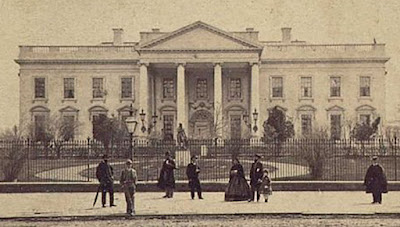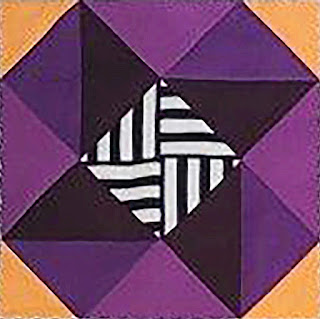Washington Whirlwind #4: Next Door Neighbor by Becky Collis
It seems a little hard to believe now but the grounds and building were open to the public. In the theory that the mansion was the "people's house" anyone could walk in day or night as they wished, too many picking up knick-knacks and cutting swatches out of the drapes for souvenirs.
The "President's House" is below the purple star
in the "President's Park."in this 1861 map from Margaret Leech's
Reveille in Washington. (See more below.)
Julia Taft Bayne (1845-1933)
She was in her mid-teens when she met the Lincolns.
When her younger brothers were invited to play with the Lincoln children Julia was encouraged to accompany them, perhaps to do some supervising. She enjoyed the visits, remembering how the Lincoln library was full of novels, reading material forbidden at home by her mother Mary Cook Taft. While the boys disrupted cabinet meetings with drums and horns Julia spent time chatting with Mary Todd Lincoln, whose kind company she appreciated.
The President also encountered Julia in the library or parlor.
In her memoir Julia recalled attending Madame Smith's French School (west of the White House in the current map here) during the Civil War years but a little fact checking reveals that Madame Smith's school was closed by the time Julia joined her family in Washington. Her father's diary mentioned that the empty Smith school was housing soldiers and Julia had begun schooling with a Miss Douglas on H Street as the war began." I was sitting on the sofa with some silk and velvet pieces on my lap, out of which I was trying to make a pin-cushion. The President came into the room. I rose at once, my pieces falling on the floor. When the President went out, I picked them up and was just getting them sorted out again when he came in the second time. True to my training, I again rose and the silk once more scattered to the floor.‘You needn’t get up, Julia, every time Abram comes in the room,’ said Mrs. Lincoln.
‘Why, Julie,’ said the President, noticing my silk pieces on the floor, ‘that’s too bad.’ Before I knew what he was about, he had knelt on the floor and was picking up the pieces of silk for me."
National Museum of American History
Dress worn by Mary Todd Lincoln
Purple was a favorite color of the First Lady and
other fashionable women at the time.
Empress Eugenie of France (1826-1920)
by Franz Xaver Winterhalter
Mary Lincoln considered herself the American version of the Empress and directed her seamstresses to copy Eugenie's style. Julia Taft remembered that Mary Todd Lincoln was wearing "lilac organdy" when they met.
Next Door Neighbor by Becky Brown
Despite her mother's conservative nature and refusal to wear a crinoline (an "abiding grievance" to Julia) Mrs. Taft also liked the new purples and bought a particularly elegant bonnet at Willian's on Pennsylvania Avenue.
1855
Her ensemble of bonnet with purple ribbons, a purple and white silk gown and lavender kid gloves attracted Mary Lincoln's attention, but rather than complimenting Mary Taft on her taste Mary Lincoln demanded the ribbons. Willian's was out of that particular "riband" (as they termed them) and the First Lady wanted some. Julia overheard her mother discussing the request. "I suppose I'll have to let her have it and it's provoking, for I really did like this bonnet."
Next Door Neighbor by Denniele Bohannon
William Howard Russell, British correspondent for the London Times, attended the theatre in November,1861 noting the first lady's attire in his diary: "Mrs. Lincoln in an awful bonnet."
The next day he hadn't recovered, recalling her as "the most preposterous looking female I ever saw."
The fashion for purple in wartime Washington may inspire color choices for your Next Door Neighbor block.
The Block
At the end of the 19th century the Ladies Art Company was calling this block of triangles
Next Door Neighbor.
Next Door Neighbor by Jeanne Arnieri
Further Reading
Extensive preview:
https://books.google.com/books?id=MmkZzJWv21MC&printsec=frontcover&dq=reveille+in+washington+1860-1865&hl=en&newbks=1&newbks_redir=0&sa=X&ved=2ahUKEwjUlaedgNGEAxW4lokEHWURAA8Q6AF6BAgNEAI#v=onepage&q&f=false

















No comments:
Post a Comment